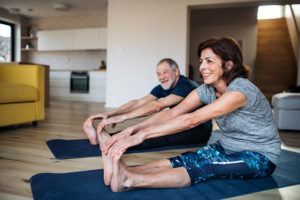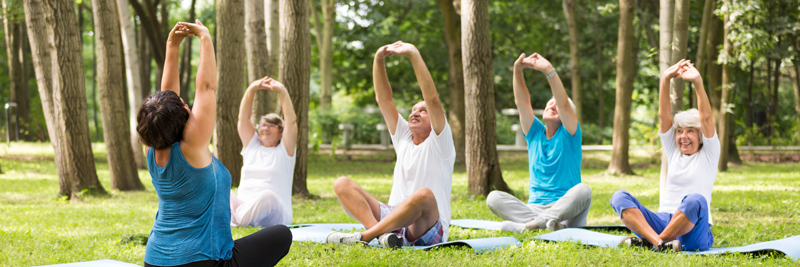6 Benefits of Stretching & 12 Daily Stretches
I keep forgetting I’m no longer sixteen. My mind forgets, but my body doesn’t (I like my mind much better). The aches and pains of a 61-year-old body are catching up to me. Yesterday, I went to play tennis at 6 am. I got there early to stretch and get ready. The first thing I tried was touching my toes. I bent over but was unable to comfortably extend much further than my ankles. Was I leaning over a barrel? I could see my toes, but my fingers were, unfortunately, not reaching past my ankles. Thankfully, I had arrived early and did not have an audience. I slowly raised back up and eagerly moved on to a less humbling stretch.
No one I know has had a pain free life, and I am certainly not the exception. I have had more than my share of broken bones, stitches, pulled muscles, and sprains. Being hurt or injured is never fun. In my teens I could “play through the pain”, but over the years that mentality has become a distant memory. Today, my mindset is ibuprofen, ice, rest, and not starting back before my body tells me it’s ready. Since I have only one body, I intend to take better care of it. I decided to find a way to minimize my ever-increasing aches and pains. My research showed me the importance of stretching daily as well as before and after working out or playing a sport.
The Importance of Stretching
Like many people, I spend far too much time watching my “lobotomy box”. The majority of my viewing, though, is confined to old movies from the 1930s and ’40s and sports channels. It didn’t take long to figure out what my topic this week would be. I happened to watch an ESPN interview and the athlete being interviewed was crediting his new-found stretching routine for helping his performance and recovery time after a game. Shortly after the program ended I went online and researched seniors and stretching.
My research uncovered over 7 million articles on the subject. I’m guessing that not every article was wholly dedicated to seniors or stretching, but one might infer that it is a topic of relative importance. My goal is not to beat you up with statistics on the benefits of exercise, I’ve done that in earlier articles. I’m assuming you already know it’s beneficial. Today, my intent is to share some benefits of stretching and a few daily recommended stretches. Before I list any benefits, let me share why it is especially important for seniors to do daily stretching exercises. Explaining the importance much better than I could ever hope, Healthcare Therapy Services1, a physical therapy clinic in Greenwood, IN, states on their website:
“As we age, our muscles become shorter and lose their elasticity… Stretching is an important part of a senior’s flexibility and will help offset the effects of the normal decline in the flexibility of joints and help them remain active and independent. It is extremely important to keep muscles strong, even when one cannot walk or move for long periods of time. This is where stretching for seniors carries the most benefits…”
The Benefits
Natasha Freutel, a certified personal trainer, occupational therapist, and freelance writer, in January of 2016 penned an article for Healthline2, listing the benefits seniors could experience from a daily stretching routine. Included were:
- Increased Flexibility;
- Improved Posture;
- Released Muscle Tension and Soreness;
- Reduced Risk of Injury;
- Increased Circulation and Muscle Control;
- Improved Balance
Stretches for Seniors

We know now what the benefits are, but what stretches do seniors need to perform daily? Yuri Elkaim, a well-known author and fitness coach3 and self-described “healthpreneur”, says there are nine stretches seniors should do every day. I’ve listed these and just for fun added three more4. Here they are:
Upper Body Stretches
- Neck Stretch– This will lessen the tension in your neck and shoulders. Start by sitting in a chair with your back straight. First, gently move your neck from left to right. Next, raise your right arm and place it on the left side of your face. Gently pull your neck to the right, holding the position for 20 seconds. Repeat with the left arm.
- Triceps Stretch– Good for improving range of motion and flexibility in the arm and upper back. You can do this sitting or standing. Extend your right arm straight up and bend at the elbow. Grab the elbow with your left hand and gently pull downward, hold for 20 seconds. Repeat with the left arm.
- Shoulder and Upper Back Stretch – Will help in not letting your shoulders hunch Sit or stand and extend both arms behind your back, clasping your hands. If possible, extend your arms upward away from your back. Hold for 20 seconds.
- Lower Back Stretches – Good for stretching your lower back. Start by standing straight, placing your hands on your hips. Gently arch your back, looking upward. Hold for 10 seconds. Do 10 repetitions.
- Chest Stretches – Increases flexibility in the torso, helping with functional movements like reaching for or grabbing objects. Sitting or standing, take the right arm and reach horizontally to the left side, gently turning your trunk. Hold for 5 seconds. Repeat 10 times, then repeat with left arm.
- Side Reach– Good for increasing flexibility and helping in reaching for objects at eye level or higher. Sitting in a standing, move your feet slightly wider than your hips. With your right arm, reach to the right until you feel a slight pull on your left trunk. Hold for 5 seconds, doing two sets of ten repetitions. Repeat with left arm.
Lower Body Stretches
- Quadriceps Stretch – Helps lengthen the quadriceps, aiding in better posture. Stand up, holding onto a table or chair for balance. Lift either leg, grabbing the foot, and holding for 10 seconds. Repeat with the other leg.
- Hip Stretches – Helps increase the range of motion and flexibility. Aids in getting out of cars or a bathtub. Sit straight in a chair, place your right leg over your left. Hold for 30 seconds. Repeat with left leg.
- Ankle Stretches – Increases strength, flexibility, and balance, decreasing the possibility of a bad fall. Sit in a chair, extend your right leg and rotate your ankle clockwise 10 to 20 times, and then counter-clockwise 10 to 20 repetitions. Repeat with the left ankle.
- Cat-Cow Pose– Yoga pose that increases flexibility and mobility of the spine. Get on all fours, making sure your hands are directly beneath your shoulder and knees directly under the hips. Take a deep breath, arch your spine upward, and lower your head. Next, exhale, moving your head and shoulders upward, and dropping your back. Do 10 to 15 repetitions.
- Lower Back & Hamstring Stretches – Improves posture. Laying flat on your back, bend the right leg, and while keeping your shoulders on the floor grab your knee, pulling it toward your shoulder. Hold for 20 seconds. Repeat with left leg.
- Toe touches – (You saw this one coming). Good for increasing flexibility. Sitting or standing, lean forward, extending the hands to the toes. Hold for 5 seconds. Repeat 10 times.
Why Stretch?

As I have shown, stretching is important and not just for seniors. It helps with flexibility, balance, and muscle control. For seniors, a daily stretching routine can help maintain independence and an active lifestyle. It’s incumbent upon adult children to encourage their elderly parents to take up stretching. Doing so will help them maintain their independence. The above stretches are, again, not the only ones out there. There are many more plus variations of those I’ve listed. I hope you found these ideas helpful and prodded you to continue or start a beneficial routine.
Stretching cannot be over-emphasized. With this in mind, I invite you to share below how you or a loved one has benefitted from a stretching routine
Footnotes:
1). https://www.htstherapy.com/3-stretches-ease-lower-back-pain/
2). https://www.healthline.com/health/senior-health/stretching-exercises#1
3). https://yurielkaim.com/stretching-exercises-seniors/
4). https://aaptiv.com/magazine/stretches-for-seniors



Recent Comments